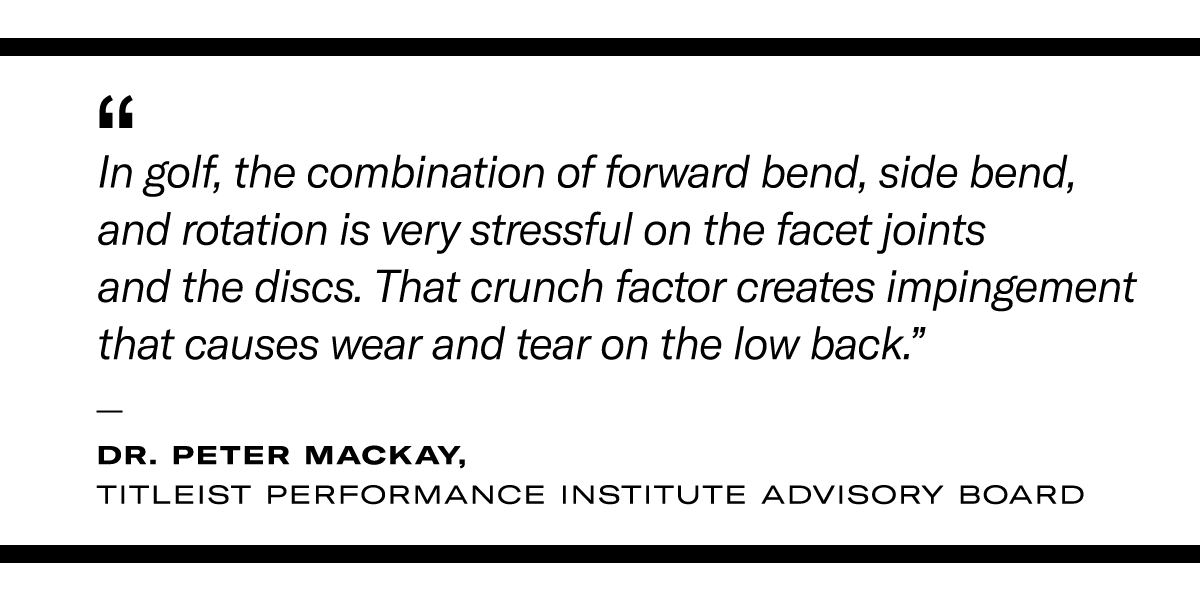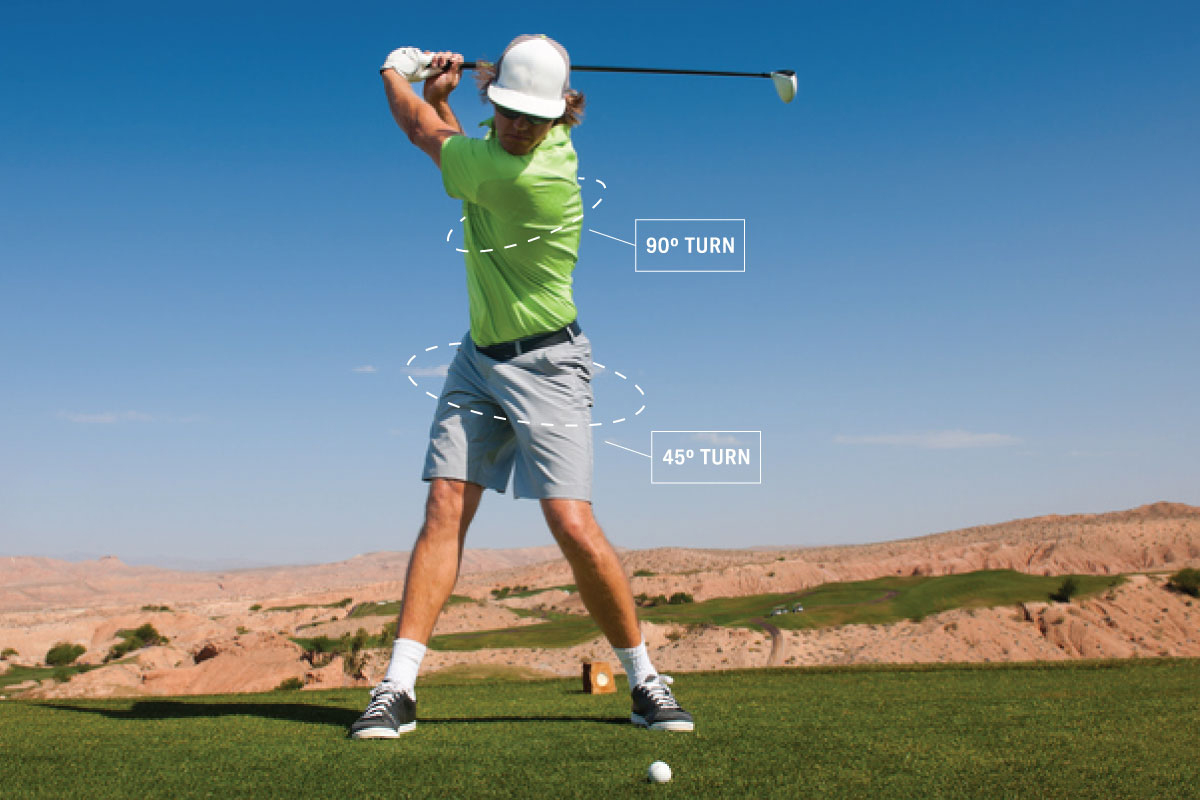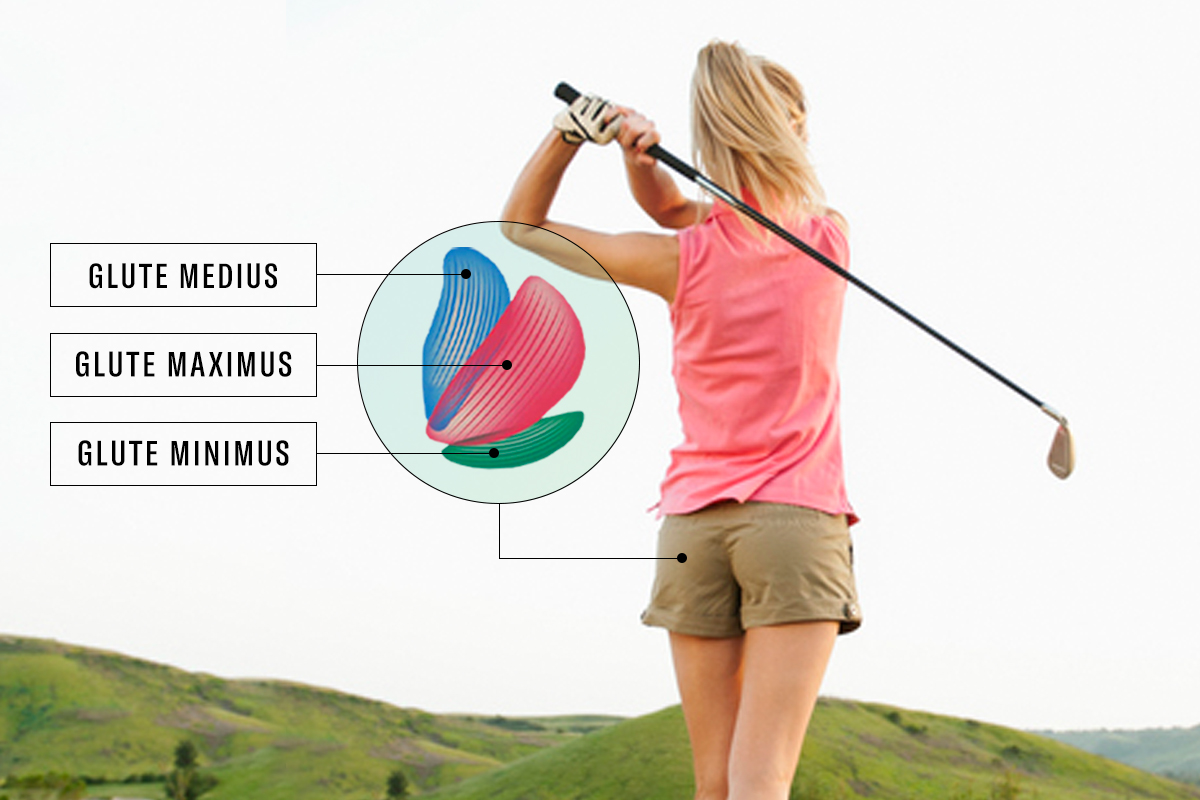Increasing range of motion in your thoracic spine can improve your golf swing and prevent injuries.
You wouldn’t think golf has much in common with sports like football or soccer, but a 2022 research review found that the forces that travel through the lumbar spine while swinging a golf club are similar to those of other contact sports. So if after a round you have lower back pain like you got leveled by a defensive lineman, don’t be too surprised.
First, Why Does Lower Back Pain Occur?
Research shows lower-back issues account for 25 percent of all golf injuries, though incidence rates of up to 54 percent have been reported. During the golf swing, body parts move at high velocity through extreme ranges of motion, causing many young, old, professional, and amateur golfers with low back pain to actually have the same issues in their lumbar spines as athletes in contact sports.
The issue, however, may not be with the lower back itself. The joints of the lower spine allow for flexion and extension, or movement forward and backward, but not for rotation. However, the vertebrae of the thoracic spine, which is above your lower back, are designed for rotation in addition to flexion and extension. So are the hips, but golfers commonly lack range of motion in these areas. During the golf swing, the lumbar spine should remain stable while the hips and thoracic spine rotate. If you’re lacking mobility in the hips or thoracic spine, the lumbar spine will be forced to do too much, causing pain and injury. Conversely, opening up those areas with exercise can prevent lower back injuries.

What Does the Thoracic Spine Do During the Golf Swing?
In the golf swing, force is generated from the ground up. It travels from the feet, through the legs, hips, torso, and shoulders, then finally into the arms and the ball. During that kinetic sequence, once the pelvis has turned toward the target, the thoracic spine must bend, tilt, and twist to get the club to the ball at the proper angle.
“In golf, the combination of forward bend, side bend, and rotation is very stressful on the facet joints and the discs,” says Dr. Peter Mackay, a chiropractor and Titleist Performance Institute advisory board member. “That crunch factor creates impingement that causes wear and tear on the low back.”
This is an issue even for golfers with good thoracic mobility, but those with limited mobility are more at risk, because they have to make up for it somewhere else. Those golfers will often over-rotate the pelvis, lift the arms, and lose posture during the swing, Mackay explains, which leads to compensatory patterns that can cause poor shots as well as pain or injury.

How Do You Test For Thoracic Mobility?
Thoracic mobility is important for the golf swing, and for general life as well. Moving your body in the proper kinematic sequence can greatly improve your mobility.
“Think about checking your blind spot in your car,” Mackay says. “If you sit tall, then turn your chest first in the direction you want to look, your head will follow with less stress.” However, because most people have limited thoracic mobility, they lead with the head first. Here are a few ways you can assess the mobility of your thoracic spine.
Assessing Extension
Part 1: Stand flat against a wall, with the glutes, low back, upper back, and head flat against the wall. Because many of us spend hours a day slouched over laptops and cell phones in excessive flexion—hunched forward with a rounded back—simply standing flat against the wall can be difficult.
Part 2: If you can get your glutes, low back, upper back, and head flat against the wall, raise your arms straight out in front of you, palms down, and bring them overhead until the back of the hands touch the wall. If you cannot get your hands to the wall without the low back, mid back, or head coming off the wall, your thoracic mobility is limited. The thoracic spine has to move for the arms to move overhead.
Assessing Rotation
The Mirror Test: Stand tall with your back to a mirror and your shoulders square. While keeping your hips square, rotate one shoulder toward the mirror. You should be able to see your opposite shoulder in the mirror.
How To Increase Thoracic Mobility
Self Myofascial Release
Using a foam roller or two tennis balls duct taped together, massage the muscles adjacent to your thoracic spine. The foam roller or tennis balls should not touch the vertebrae. If the area is too tender for massage, simply stretch back over the foam roller and allow the upper back to relax and open.
Thoracic Mobility Exercises
Exercises like cat cow and the reach and rotate opener can help increase range of motion in the thoracic spine. On Tonal, Mobility for Golfers and Yoga for Golfers focus on restoring mobility and increasing rotation.
Strengthening Exercises
Anti-rotation exercises like the pillar bridge with row will strengthen the muscles that drive rotation in the golf swing. A wide-grip row with a focus on scapular retraction—think of squeezing a pencil between your shoulder blades—will strengthen the rear deltoids and rotator cuff muscles. Performing overhead squats with a resistance band pulled taut overhead forces you to activate the shoulder and upper back muscles to maintain shoulder flexion and a neutral thoracic spine. Exercises that strengthen the core can also reduce stress on the lower back.

Finding Balance
“The golf swing is very repetitive, stressful, and ballistic in one direction,” Mackay says. “You simply can’t swing a golf club as many times in the opposite direction to make up for all the swings in a round of golf or a tournament.”
However, Mackay suggests using Tonal for loaded, rotational exercises in the opposite direction to counter the pattern of your golf swing so the repetition doesn’t wear you down. Mackay also says it is important to remember that recovery training like this is very different than training for speed, strength, or power, and should be done slowly and deliberately, with a focus on range of motion.
The information provided in this article is for educational and informational purposes only. Individuals with pre-existing health conditions, injuries, or concerns should consult with their healthcare provider before trying a new exercise or nutrition regimen.



